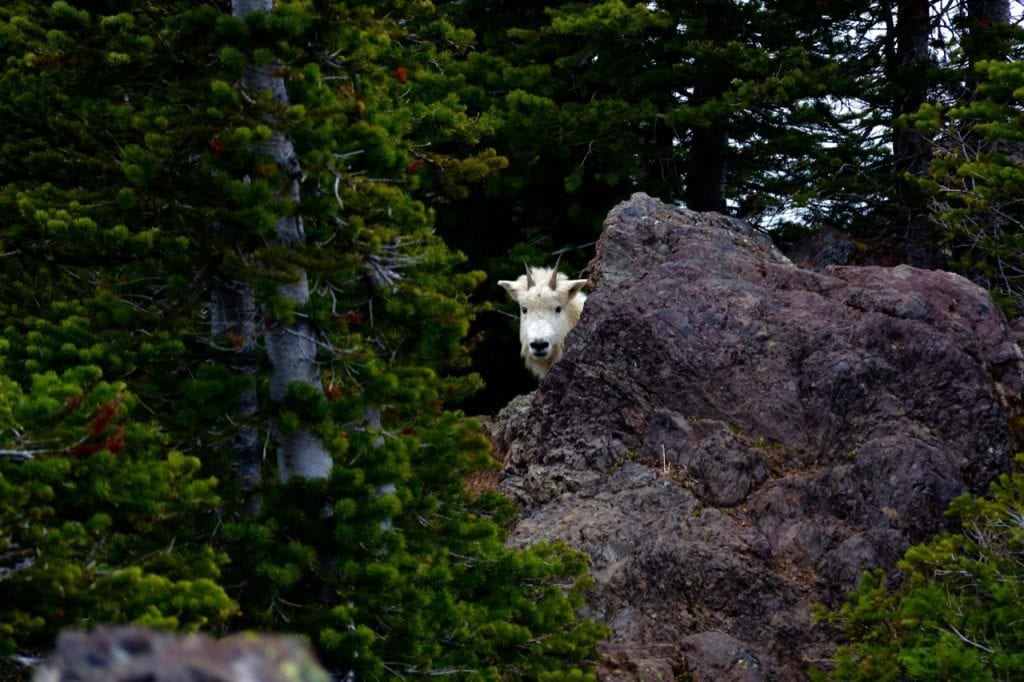The Olympic Mountains loom large to the west of Tacoma and Pierce County. The mountains are where we hike and camp, wander, relax and recharge during our days off. At the end of this past summer, the land of tranquility and wonder transformed into the  location of a remarkable and memorable airlift operation. You probably saw the pictures and heard a few reports, but this is the story of the great mountain goat move of 2018 – and how four lucky mountain goat kids found a new home at Eatonville’s Northwest Wildlife Trek Wildlife Park.
location of a remarkable and memorable airlift operation. You probably saw the pictures and heard a few reports, but this is the story of the great mountain goat move of 2018 – and how four lucky mountain goat kids found a new home at Eatonville’s Northwest Wildlife Trek Wildlife Park.
Mountain goats are not native to the Olympic Mountains, but their history in the region is quite fascinating. They were placed in the region from Canada and Alaska by the Forest Service way back in the 1920s, in hopes to make the area a hunting destination for sportsman. Over the next five decades, without any hunting, the goat population exploded. The number of these iconic ungulates quickly climbed from the original 12, reaching the upper hundreds. With no predators, alpine areas became trampled, vegetation in the upper elevations started to diminish and human interactions with the goats increased.
In the early 1980s, the goats were studied to see just what their impact on the landscape was, and if their removal would have a positive impact on the area. While biologists around the region shared their findings and said there was an issue with keeping the goats, the population of mountain goats in the Olympics continued to flourish.
In 2010, a known aggressive mountain goat charged a hiker who was too close to the horned animal, brutally goring him in the leg, killing the man. This unfortunate death, the first known mountain goat attack and death, was one of the reasons the debate to once again try to remove the mountain goats was started.

In 2014, the Park and National Forest Service asked for the public’s opinion on the matter, with the option of doing nothing or removing the goats. After three years, the powers that be decided to once again attempt to remove the goats from the Peninsula, thanks to more than 2,400 public comments, setting up the scene to capture not just the goats but also the dramatic images that were impossible to miss this past September.
For nearly two weeks, crews worked around the ridges of the northern Olympics, tranquilizing, airlifting and trucking mountain goats to the North Cascades, where they are struggling to survive in their native habitat. In the first of many moves, 98 mountain goats were relocated from Olympic National Park to the northern Cascade Mountains, including 11 kids that were released with their nannies. Unfortunately, during the great goat roundup of 2018, a few goats fell to their deaths, leaving their months’ old offspring out in the elements.
Instead of capturing them and testing their luck in the wild, the newly orphaned mountain goat kids were gathered together and shipped somewhere where they will live out their days safer and more spoiled compared to their wild relatives. They were driven to Northwest Wildlife Trek Wildlife Park, giving the Olympic Mountain goats a direct tie to our neck of the woods.
“Our plan is to translocate nanny-kid pairs when possible,” shared Rich Harris, Washington Department of Fish and Wildlife statewide mountain goat manager. “But when young goats cannot be paired up with their mothers, experience from other mountain goat translocation projects is that their survival rates are low.”
Six mountain goat kids that could not be paired up with their mothers were transferred to Northwest Wildlife Trek Wildlife Park. One of the six joined a herd at Woodland Park Zoo last week and another eventually will have a new home at another zoo.
The four young goats that will remain at Northwest Wildlife Trek were given names that represent their Olympic Heritage, donning monikers of mountains and rivers of the region. The two females Fairchild and Bailey and males Klahhane and Elwha are no longer roaming the rugged Olympics; instead they will be roaming through meadows, forested areas and rocky hillsides.

“We are delighted to provide a permanent home at Northwest Trek for these mountain goat kids,” said Andrea Smith, president of the Metro Parks Tacoma Board of Commissioners. “We know our visitors will appreciate seeing them grow up and learning about their conservation success story.”
On November 13, 2018, the four mountain goats orphaned in the Olympics were released from their enclosures into the vast expanses of the 435-acre Free-Roaming Area at Northwest Wildlife Trek Wildlife Park. After nearly two months of being under the watchful eye of the Northwest Trek staff, the goats are now part of the landscape, living it up in an area filled with bison, moose, elk and other mountain goats. Visible from the naturalist-narrated tram tour, which comes free with admission, Fairchild, Bailey, Klahhane and Elwha are now delighting visitors young and old.
For an even better look at these goats and all the animals at Northwest Trek, you can reserve a seat on a Keeper Adventure Tour, which is a premium off-road Free-Roaming Area experience.
To see the goats and all the wildlife attractions at Northwest Wildlife Trek Wildlife Park, head down toward Eatonville and explore this incredible regional destination. With hours of operation varying by season, check out the website to see when you should plan your next visit.




































